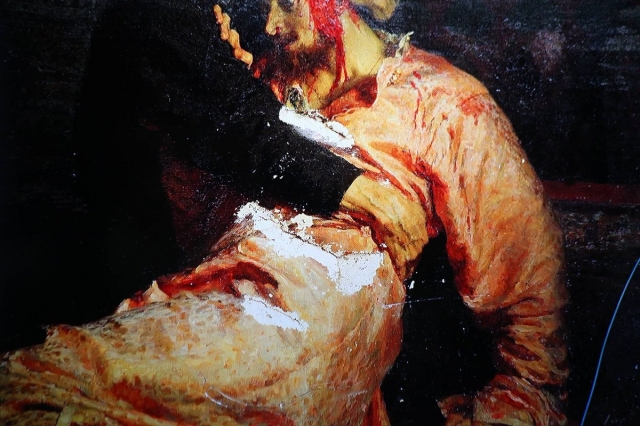Repin Masterpiece "Ivan the Terrible" Seriously Damaged
At Moscow’s Tretyakov Gallery a man has inflicted serious damage to the painting “Ivan the Terrible and His Son Ivan November 16, 1581.” Completed by one of Russia’s most famous artists, Ilya Repin, in 1885, the painting has a somewhat controversial place among Russian art. It depicts a scene in the life of Ivan the Terrible (also known as Ivan Grozny or Ivan IV Vasilyevich), cradling his eldest son’s dead body after accidently murdering him in a fit of rage.
The masterpiece was badly damaged just before the gallery closed on Friday when a man lunged at it with a metal pole. A statement released by the Tretyakov Gallery said, “As a result of the blows the thick glass ... was smashed. Serious damage was done to the painting. The canvas was pierced in three places in the central part of the work which depicts the figure of the tsarevich [the tsar’s son].”
Ivan Grozny has become a historical figure of contention recently in Russia. Some nationalists dispute his characterization as mentality unstable and violent, and question the veracity of the story of his son’s death. For this reason, Repin’s painting, created more than 300 years after the fact, has become an object of controversy. Some reports of the incident claim that the attacker was compelled by feelings that the painting was slanderous and inaccurate. Some nationalists claim that many Russian rulers’ bad reputations were falsely created as part of a western or Catholic campaign to vilify Russia. Georgian-born Soviet leader Josef Stalin has been a particular target of such revisionist history, but Ivan Grozny has gotten attention as well.
As The Guardian describes, “Battles over historical narratives in Russia have become increasingly heated under [Russian President] Vladimir Putin as the Kremlin pushes a more positive, patriotic view of Russian history.” Last year, Putin commented on Ivan Grozny’s reputation, saying, “Many researchers think that he didn’t kill anyone at all, and that this was concocted by a Papal emissary who came to Russia for negotiations and wanted to turn Orthodox Russia into Catholic Russia ... But after Ivan refused and told him to get lost, several legends began to spring up. They began to label him ‘Ivan the Terrible’.” Claims have been made that the painting itself was part of the campaign to blacken Ivan Grozny’s reputation in the late 19th century.
The Tetryakov refused to remove the painting in 2013 after demands by a group of Orthodox Christian activists, who argued that the painting was offensive to Russians for its inaccuracy. The painting has faced opposition since its creation. When the painting was first displayed in the Tretyakov Gallery after its completion in 1885, it was temporary banned from public display for offending then-Tsar Alexander III.
The attack mirrors a similar incident in 1913, when a mentally ill man left three knife wounds in the canvas. Repin himself, who lived until 1930, restored the painting then. This time, museum representatives rejoice that “by a happy coincidence” the faces and hands of Ivan and his son are unmarred. The Tretyakov plans to restore the painting again, and will convene a “special commission of leading Russian experts to plan a course of action and oversee its restoration, which will likely take several years, if previous restoration efforts are any indication,” according to reports in The Guardian.
The suspect’s name has not been made public, but the Russian interior ministry released some information on the attack, including a video in which he seems to confess, saying that he visited the painting after stopping by the museum’s cafeteria and drinking a shot of vodka, and became “overwhelmed by something.” The interior ministry says that the man passed several gallery staff members, grabbed a metal pole used to separate the public viewing area from the painting, and slammed it several times into the protective glass case. The painting’s frame also sustained serious damage. Local Russian media have reported the culprit as being a 37-year-old man from Voronezh, about 460 km from Moscow. He has been detained and faces charges of damaging a cultural artefact. If convicted, he will face up to three years in prison and a 3 million Ruble fine, according to RIA Novosti service.
RIA Novosti reports that experts say the canvas may need to be replaced, but the outlook is positive, especially since Repin left notes from the 1913 restoration.
By Samantha Guthrie
Photo: Kevin Rothrock












